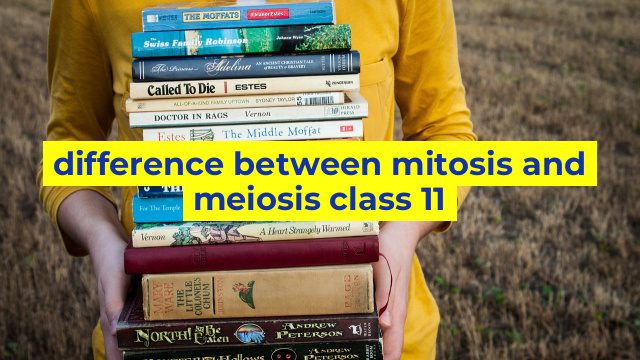Understanding the Difference between Mitosis and Meiosis at Class 11 Level
Mitosis and meiosis are two of the most crucial cell division processes that occur in living organisms. Both mitosis and meiosis are crucial for the growth, development, and reproduction of organisms. However, they differ in terms of the number of daughter cells produced, the type of cells involved, and the purpose of the division process. In this article, we will discuss the differences between mitosis and meiosis at the class 11 level.
Mitosis
Mitosis is a type of cell division that occurs in somatic cells or non-sex cells. This process involves the splitting of the nucleus into two identical daughter nuclei, each with the same number of chromosomes as the parent cell. Mitosis produces two diploid cells, which means they contain two sets of chromosomes. The primary purpose of mitosis is cell growth, repair, and replacement of old cells.
Mitosis is divided into four stages, namely prophase, metaphase, anaphase, and telophase. In the prophase stage, the chromatin condenses into chromosomes, the nuclear envelope breaks down, and the spindle fibers start to form. In metaphase, the chromosomes align at the center of the cell, and the spindle fibers attach to the centromeres. In anaphase, the spindle fibers contract, and the sister chromatids separate and move towards opposite ends of the cell. Finally, in telophase, the nuclear envelope reforms around each set of chromosomes, and the cytoplasm divides through cytokinesis or cell division.
Meiosis
Meiosis, on the other hand, is a type of cell division that occurs in reproductive cells or germ cells. This process involves two rounds of division, resulting in four non-identical haploid daughter cells, which means they contain half the number of chromosomes as the parent cell. Meiosis has the primary purpose of sexual reproduction and the creation of genetic diversity.
Meiosis is divided into two stages: meiosis I and meiosis II. In meiosis I, homologous chromosomes pair up and exchange genetic material in a process called crossing over. This results in genetic diversity among the daughter cells. In meiosis II, the sister chromatids separate, resulting in four haploid daughter cells. Like mitosis, meiosis also goes through four stages, namely prophase I, metaphase I, anaphase I, and telophase I.
Conclusion
In summary, while mitosis and meiosis are both essential cell division processes, they serve different purposes and occur in different types of cells. Mitosis creates two identical diploid daughter cells responsible for growth, repair, and replacement of old cells. Meiosis creates four non-identical haploid daughter cells responsible for sexual reproduction and genetic diversity. Understanding these differences is crucial for class 11 students studying biology, as it forms the foundation of a variety of complex biological processes that follow.
Table difference between mitosis and meiosis class 11
| Mitosis | Meiosis | |
|---|---|---|
| Definition | The process of cell division in which a single cell divides into two identical daughter cells, each containing the same number of chromosomes as the parent cell. | The process of cell division in which a single cell divides into four genetically diverse daughter cells, each containing half the number of chromosomes as the parent cell. |
| Cell types | Asexual reproduction, growth, and repair of tissues in somatic cells. | Sexual reproduction in gamete cells. |
| Number of divisions | One division | Two divisions |
| Chromosome number of daughter cells | Same as the parent cell | Half the number of chromosomes as the parent cell |
| Genetic variation | Minimal or no genetic variation | Significant genetic variation due to crossing-over and independent assortment of chromosomes during meiosis I and II respectively. |
| Stages | Prophase, metaphase, anaphase, and telophase. | Meiosis I and Meiosis II, both consisting of prophase, metaphase, anaphase, and telophase. |
